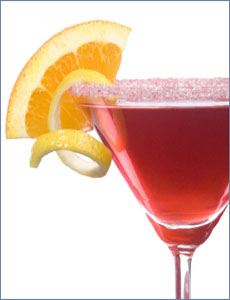
May 2009
|
 |
All About Vodka
Page 2: Vodka History, Vodka Trivia
This is Page 2 of a 3-page article. Click the black links below to visit other pages.
The History Of Vodka (Continued)
In the 1960s, vodka got a second boost from a man named Bond, James Bond. Agent 007’s “vodka martini, shaken not stirred” catapulted this now-classic cocktail to instant stardom. The vodka martini took center stage again when Carrie Bradshaw and her crew began sipping fancy flavored martinis, including Cosmopolitan Martinis (four parts citron vodka, two parts Cointreau or triple sec, two parts cranberry juice and one part fresh lime juice) in hip New York clubs on HBO’s hit “Sex and the City”...as well as Apple Martinis, Flirtinis (vodka, Champagne and pineapple juice), Chocolate Martinis and “tinis.” Vodka martini madness swept across the U.S. Some “martini bars” boasted hundreds different of martini cocktails.
Today, vodka accounts for more than one out of every four bottles of distilled spirits consumed in the U.S. America loves its vodka: Super-premium (high-quality, handcrafted) is now the fastest growing vodka segment in the U.S. Sales figures grew nearly 50% between 2000 and 2003, and super-premium now constitutes nearly 40% of total vodka sales.
Vodka Trivia
- The Word. The word “vodka” comes from the Russian words zhiznennia voda, which mean “water of life”
(the literal translation is “little water”). Interestingly, this is the same translation for “whiskey”: The Gaelic uisce beatha, pronounced ISH-ka BYA-ha, which evolved to the modern word, whiskey, also means “water of life.” (It is also spelled uisge baugh, ISH-ka BA-ha.)
- Aging. Unlike whiskey, no aging or maturation period is required for vodka.
- Ingredients. Just about anything fermentable can be used to make vodka—potatoes, sugar cane, barley,
molasses, even beets. Rye and wheat are the classic grains; most of the best Russian and Swedish vodkas use wheat while Polish vodkas have a preference for rye. Molasses is used for inexpensive, mass-produced brands. American distillers use the full range of base ingredients, depending on price range and preference.
- Potato Vodka Is Gluten Free. Since it isn’t distilled from grain like wheat and rye vodka, potato vodka can be enjoyed by people who have gluten allergies. Some excellent vodkas are made from potatoes, like Cold River Vodka, distilled in Maine.
- Character. A vodka’s water, its base ingredient and its filtration method are all important to its character. Potato
vodkas, for example have a subtle hint of sweetness not present in other varieties. When you find particular brands that you prefer, check to see what the base ingredient is. You may be a wheat person, a winter wheat vodka person or a rye vodka lover.
- Style. In Eastern Europe, vodka is commonly drunk “neat” and ice-cold in iced glasses, which some people believe is the best way to enjoy premium vodka. (At THE NIBBLE, we keep our vodka and our glasses in the freezer.)
Continue To Page 3: Vodka Cocktail Recipes
Go To The Article Index Above

|




